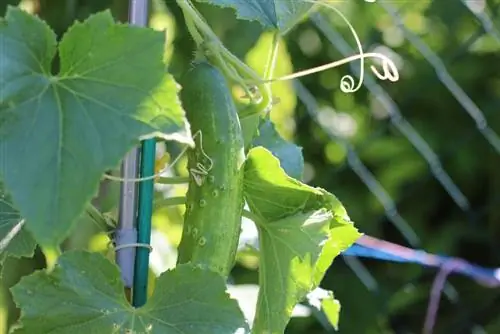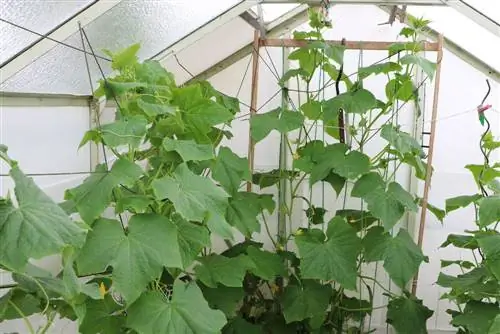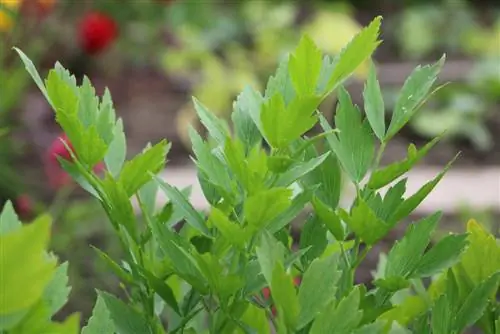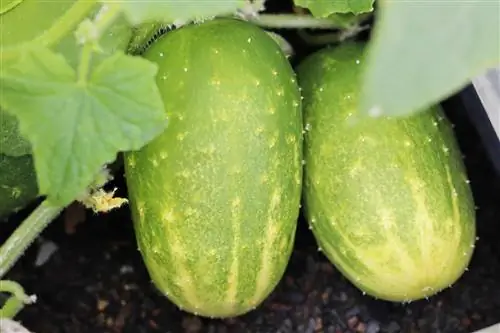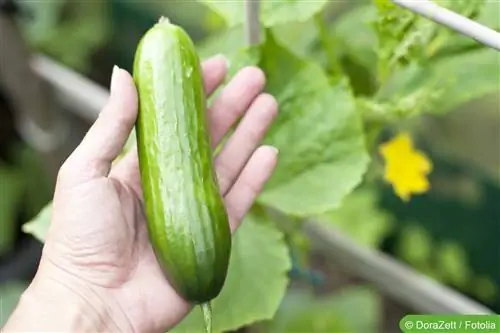- Author admin [email protected].
- Public 2023-12-17 03:39.
- Last modified 2025-06-01 06:48.
Gherkins as a side dish or as a topping on a sandwich are a crunchy delicacy - and they are particularly tasty when everything from cultivation to preparation has been done by hand. You don't even need a bed in the garden; the balcony is also sufficient for cultivating the plants. In any case, it is important to know the crucial points of care and, of course, suitable recipes for delicious preservation.
variety selection
In principle, any type of cucumber can be used to grow pickling cucumbers. Breeds of cucumbers are also suitable for pickling when harvested early. The selection of varieties can therefore be based on taste and harvest time. However, the easiest way is to use special gherkins or pickling cucumbers. Robust variants are particularly recommended for outdoor cultivation, such as:
- Bidretta
- Charlotte
- Conny
- Eva
- Excelsior
Location
Cucumber plants like it bright, warm and protected. They are sensitive to frost and cold wind. There are therefore two options for the location - either a greenhouse is used for cultivation or a place protected from the wind with lots of sunlight is chosen. For example, the south side and areas near a wall or wall are ideal.
Substrate
The substrate for growing pickles should have the following properties:
- loose and permeable
- light and not prone to compaction
- neutral to slightly alkaline with a pH value of around 7
Ideal is garden soil or vegetable soil, which is also mixed with sand and loosened up.
Tip:
A layer of mulch around the plants reduces evaporation, prevents weeds from sprouting and also provides additional protection for the roots.
Advancing and sowing
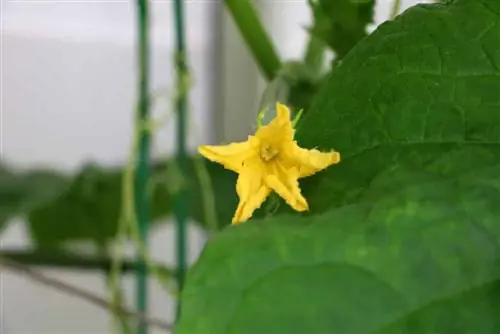
With sufficient heat and light, the seeds quickly become seedlings, so growing or sowing does not have to be done too early. A lead time of three to four weeks is completely sufficient. In fact, pre-breeding should not be done too early, as the young plants could already be too large when planted out. Pre-breeding is still recommended because cucumber plants are very sensitive to frost. It is started in April so that the plants can be planted out in May. The procedure is as follows:
- The seeds are placed in growing soil in seed pots or an empty egg carton and lightly covered with the substrate. These are dark germinators, so the layer of soil on the seeds should be about one centimeter.
- The substrate is slightly moistened throughout.
- The planters are either covered or placed in a mini greenhouse and placed in a bright, warm place.
- The substrate continues to be kept moist. Care should be taken to ensure that no mold forms. Daily ventilation and avoiding waterlogging have a preventive effect.
- After about a week, the first shoot tips will appear. After about three weeks, caring plants can be sorted out, i.e. the pre-cultivated ones can be pricked out.
When frost is no longer expected outside, the young plants are placed outdoors or in the greenhouse. It should be ensured that no late frost occurs or that the plants can be protected accordingly in these cases. In an insulated greenhouse, this problem is solved from the start. Pots should be brought indoors; outdoors, pads on the soil and garden fleece over the young plants at least provide protection from the worst effects of the drop in temperature. In addition, even with smaller cucumber varieties, a planting distance of at least 50 centimeters must be maintained between the plants. If there is sufficient ventilation, the plants in the pot can be a little tighter.
Water
Cucumbers are very rich in water and therefore the plants also need a regular supply. The substrate should therefore always be kept slightly moist. However, waterlogging must be avoided. Loose substrate, an addition of sand and ensured drainage of water from the planter or bed can prevent waterlogging. The already mentioned mulch layer prevents it from drying out quickly and having to be watered frequently.
Fertilize
Cucumbers are heavy feeders, which means they require large amounts of nutrients. It is therefore advisable to add appropriate fertilizer to the substrate before planting. Mature compost, compost soil or stable manure are suitable for this. Later, you can ensure regular supply with a homemade plant fertilizer by preparing nettle manure and diluting it for watering every two weeks.
This becomes:
- One kilogram of cut nettle added to ten liters of water.
- The mixture is left in a bucket for two to three weeks and stirred daily.
- If there are no more gas bubbles, the manure can be mixed with water in a ratio of 1:10 and watered with it or sprayed on the leaves. Both variants provide the cucumber plants with nutrients.
Alternatively, a slow-release fertilizer can also be used. When choosing substrate and fertilizing, however, it should be noted that the following applies to the additional nutrient supply to the cucumber plant: in moderation and not in bulk. Organic fertilizers in small quantities as well as the nettle manure described in highly diluted amounts are generally sufficient.
Blend

The trimming of cucumber plants is also known as pinching out. However, the effectiveness of this measure is controversial. There are also various instructions and advice on this topic. A particularly gentle option is to simply remove the stingy shoots. This involves culling shoots that appear in the armpits between the main trunk and side shoots. A sharp knife or clipping with your thumbnail is sufficient for this.
This should make sense, as the plant could put more energy into the formation of fruits than into the growth of leaves. However, there is no evidence of this. However, what experience has shown to be an advantage is harvesting the individual cucumbers as early as possible. If you remove these very quickly, you will encourage new flowers and fruits to form.
Tip:
It is important that the cutting and removal takes place in the morning so that the resulting cut surfaces can dry and close. A nice side effect is that there are supposed to be a lot of vitamins in the cucumbers in the morning.
Parasites, diseases and care errors
Cucumber plants are particularly susceptible to powdery mildew and the cucumber aphid. Planting robust varieties, spraying the plant and removing infected areas help combat fungal infestation. Natural predators should be used against the cucumber aphid, such as ladybirds, lacewings and hoverflies. Care errors, such as insufficient watering or waterlogging, too little or too much fertilization, are comparatively typical when growing cucumber plants and can also lead to the plants being stunted. Checking the culture conditions can help here.
Harvest
As already mentioned, the pickling cucumbers should be harvested as early as possible. If the ripe cucumbers are removed quickly, a harvest is even possible until autumn. The pickling cucumbers should not be torn off, as this will also damage the shoots. Instead, they should be cut off with a sharp knife.
If the pickling cucumbers turn yellow, you have waited too long to harvest them.
Tip:
When harvesting, it should also be taken into account that the pickling cucumbers should later fit well into the clay pot or preserving jars. Of course, this works best with small specimens.
Storage
Since there are not enough cucumbers for canning every day, the pickling cucumbers should be stored accordingly until they are prepared. They can be stored in the refrigerator or cold cellar for several days. It is important that they are kept dark and cool but not exposed to frost.
Shaked cucumber recipe
There are numerous different recipes for pickling cucumbers. Shaking cucumbers are ideal if you want the pickling cucumbers to be ready quickly and only a small amount needs to be processed. You will need:
- Gherkins, sliced
- Vinegar
- S alt
- Sugar
- ground pepper
- Mustard seeds
- Dill, fresh
- Shallots as desired
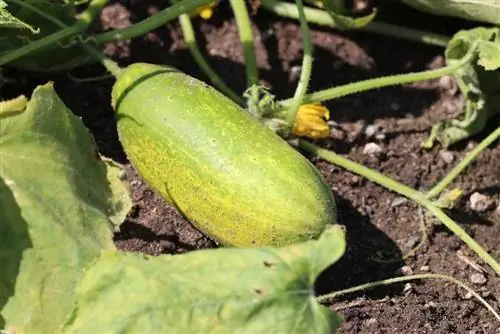
The peeled and sliced cucumbers are placed in a preserving jar. The remaining ingredients are mixed to your liking and taste and added over the cucumbers. To give an idea of the amounts of spices - half a teaspoon to two teaspoons is usually enough for one kilo of cucumbers. You can use more dill. The vinegar should just cover the pickles in the jar. After mixing, everything is poured into a glass and shaken. The pickled cucumbers are ready after just 12 hours in the refrigerator, whereby they should be shaken repeatedly. By the way, the preparation also works with cucumbers, which should, however, be peeled and seeded.
Dill pickle recipe
Another very simple pickle recipe is dill pickles. The following ingredients are necessary for preparation:
- 3 kg small or quartered pickling cucumbers
- White wine vinegar or cucumber vinegar
- Water
- S alt
- 5 to 7 teaspoons mustard seeds
- a bunch of dill with flowers
- 4 onions, if desired
The cucumbers are washed and placed in airtight preserving jars together with chopped dill, mustard seeds and onions cut as desired. Ready-made cucumber vinegar from the market or a solution of one part vinegar and two parts water as well as two tablespoons of s alt per liter of water is briefly brought to the boil and poured into the jars directly over the cucumbers. The jars are closed and boiled in a water bath for half an hour. The water does not have to boil for this, a temperature of 90 °C is sufficient. Alternatively, you can also use mason jars that are preserved in the oven.
S alted cucumbers - recipe
For two glasses with a capacity of one liter each you need:
- about 1 kg pickling cucumbers
- 2 to 3 garlic cloves
- two to four stalks of dill
- 1 liter of water
- 50 to 60 grams of s alt
- some grape leaves or sour cherry leaves
The cucumbers, leaves, dill and garlic are distributed among the jars. There should be two to three sour cherry leaves or one grape leaf per glass. The water is brought to the boil with the s alt and poured into the jars until the cucumbers are covered. The jars are sealed airtight and are finished after about one to two weeks. Once opened, they should be stored in the refrigerator.
Tip:
If the water is very hard, you can add a dash of vinegar. The quantities can be easily adjusted to the existing pickling cucumbers.
Conclusion
Growing and preparing pickles is very easy and enriches the balcony or garden and also the kitchen. Properly preserved, dill pickles and pickles can easily last for a year, saving time until the next harvest. The small amount of effort is worth it - even for beginners.

